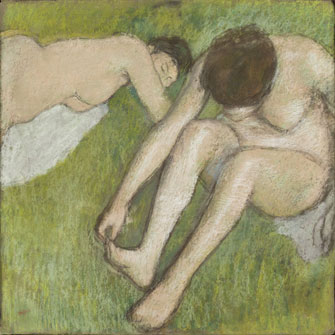Off with the Tutu,
Into the Boudoir

Degas’ ”Deux Baigneuses sur l’Herbe” (1886-90). © RMN (Musée d’Orsay)/Hervé Lewandowski
Edgar Degas (1834-1917) is, of course, best known for his depictions of dancers, but it turns out that his ballerinas often took off their tutus when the master drew them, and draw them he did, over and over again during the course of his nearly 50-year-long career. In “Degas and the Nude” at the Musée d’Orsay, the dancers are joined by assorted other women, many of them prostitutes who posed unabashedly in the company of clients or in some of their most intimate moments: during and after the bath, while grooming themselves or even sitting on the chamber pot in one powerful monotype.
Through Degas’depictions of the nude, the exhibition traces his stylistic development from the idealized bodies in the academic studies he made as a student toward more realistic interpretations and finally to the simplification of forms of the later years.
From that realistic phase, the exhibition includes one of Degas’ most haunting paintings (which doesn’t actually have a nude in it). Although entitled “Interior (The Rape)” (1868), it may or may not depict the aftermath of a rape (it could just as easily be the scene of an argument between a couple), but in any case, it certainly packs a strong emotional wallop. A man stands leaning against a door (blocking it?) hands in pockets, looking at the seated, weeping woman with her back to him on the other side of the room. His dark, looming figure is enlarged and made even more menacing by his well-defined shadow. The only light source, a lamp in the middle of the room, primarily lights up an open suitcase on a small table and the back of the woman’s white nightgown, which is falling off one of her shoulders. The scene is reflected foggily in a mirror on the back wall.
That atmospheric painting is atypical of the exhibition, however. Most of the later works focus on close-up views of the naked body in every imaginable position, many of them rather awkward – a naked woman sitting on grass picking at her toes, a woman napping on a riverbank with one arm thrown over her eyes and the other across her stomach, another one leaning over the back of a sofa in a contorted position while drying herself after a bath – most seen from unusual viewpoints or cropped in unorthodox ways.
Some of the most fascinating works here are the monotypes, like the heavy woman on the pot mentioned above, which allowed Degas to quickly create an image and then smudge it with his fingers or a piece of cloth or add texture by scratching at it with whatever instrument was at hand. He sometimes made “ghost” impressions of these prints and then added color to them with pastels.
The show is supplemented with works by artists who influenced or were influenced by Degas, among them his hero Jean-Auguste-Dominique Ingres, his great admirer Henri de Toulouse-Lautrec, Paul Gauguin, Gustave Caillebotte, Henri Matisse and Pablo Picasso.
Musée d’Orsay: 1, rue de la Légion d’Honneur, 75007 Paris. Métro: Solferino. RER: Musée d’Orsay. Tel.: 01 40 49 48 14. Open Tuesday-Sunday, 9:30 a.m.-6 p.m., until 9:45 p.m. on Thursday. Admission: €12. Through July 1. www.musee-orsay.fr
Reader Barney Kirchhoff writes: “Thanks for your review on this Orsay exhibit on Degas. Tuesday is a day when most national museums are closed. It’s a good day to combine a trip to the Orsay with a visit to the expositions at the nearby Netherlands cultural center (which you reviewed a week or so ago). If your eyeballs hold up, you can make it a triple play by stopping in at another nearby cultural center, the Maison de l’Amerique Latine, a short walk to 217 Blvd St. GermaIn, which currently has an exhibition on Jaildo Marinho. This, as well as most other shows there, is free.”
Reader Michael Barker writes: “A tip for your readers. If you first go on a Thursday afternoon to the excellent Debussy exhibition at the Orangerie – purchase the good value €14 joint ticket there which, after a stroll, gets you into the Musée d’Orsay by the side door for the late-night viewing without having to queue. To my mind, one should also take in the Gallen-Kellela exhibition at the Musée-d’Orsay. But also to my mind, if one has the energy, I advise to begin the Thursday early afternoon with the outstanding Berenice Abbott exhibition at the Jeu de Paume (and do not miss the film). I persuaded a friend to first meet at the WH Smith bookshop, rue de Rivoli, that way one can browse if a companion is delayed.”
Reader Reaction: Click here to respond to this article (your response may be published on this page and is subject to editing).
Please support Paris Update by ordering books from Paris Update’s Amazon store at no extra cost. Click on your preferred Amazon location: U.K., France, U.S.
More reviews of Paris art shows.
© 2012 Paris Update
